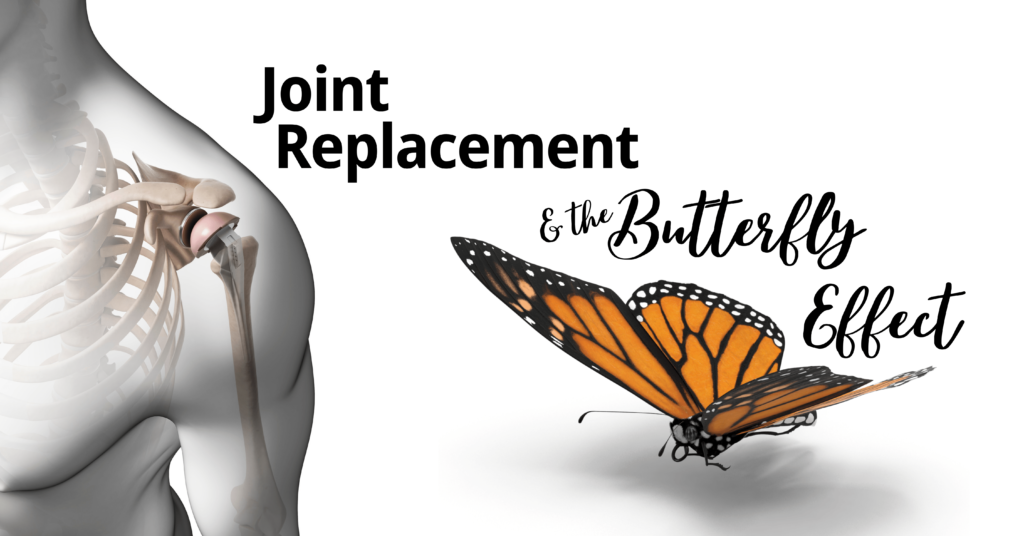
Chances are that you or someone you know has had at least one joint replaced, because every year—just in the United States—well over a million people replace worn out, painful and debilitating joints.
These days, you can replace a hip, knee, ankle, shoulder, wrist, and even an elbow, finger or toe. If two bones are coming together in a joint capsule, surgeons can generally replace that joint with titanium, plastic or ceramics.
And truly, joint replacement is a godsend for vast numbers of people.
But you know what?
Most people don’t pay any attention to why the joint replacement was needed in the first place.
Any joint that wears out and needs to be replaced didn’t get like that yesterday.
And very often it’s only ONE that needs to be replaced—what about the other side?
How come it’s not in the same shape?
Enter the Butterfly Effect
You’ve likely heard the idea that small variances early on can make big differences to what happens later.
Human bodies are complex organisms and the way we use ourselves creates imbalances and our individual “way of doing” can create the conditions that make it possible for a joint to deteriorate. Barring accident, things change slowly over the course of a lifetime of… whatever we’re doing.
It could be sports or not. Sitting or not. Walking or not.
Whatever… what we were doing 20, 30, 40 years ago affects what’s happening in our bodies today.
A lot of the problem comes from the fact that our bodies are so resilient. We have back problems and we heal. We have knee injuries and we heal.
I once put my foot between a new pointy paring knife and the floor to save the knife I’d bought on a trip to Germany and was now in the process of dropping. I’ll admit it maybe was not my smartest move—the point poked a hole in a vein and I spent 30 minutes with my foot above my heart getting it to clot—but what was in my mind at the time was that it was easier to heal my foot than replace my knife.
If that seems dumb, think back to your younger self…
Did you ever have a moment of considering a thing more important than your body?
Did you ever keep doing something you knew was going to be a problem, all the while saying telling yourself something like “I know I’ll regret this tomorrow, but…”?
Did you ever imagine how you used your body would create problems that wouldn’t show up for years?
Did it occur to you that the way you organized yourself at work could affect how much you enjoyed retirement?
Of course not. If we lived our lives that way, every type of joint replacement would number in the thousands, not hundreds of thousands.
So—fast forward to the moment when you need a joint replacement—and it’s easy to believe the new joint will be the end of the difficulty.
Imagine that you have a joint replacement…
A joint is one small part in an organism where everything works together and everything affects everything else. When you change out your old joint for a new one, there’s rarely any focus on anything else because the pain, the difficulty, the deterioration was clearly in the joint.
Why look anywhere else? Nobody needs more trouble than they already have.
So, having performed a successful operation, the surgeon goes home.
And having been released from the hospital, you slowly learn how to maneuver with your new bionic part…
And you keep on doing all the things that created the pain and difficulty in the first place.
You’re still internally organizing yourself just as you’ve done all your life.
You are still creating the conditions that caused the deterioration because the problem isn’t the joint. It never was the joint.
The pain in your joint was only the symptom of the direction your brain was giving to your body. And the direction it’s still giving because… only the joint has changed.
The hip or knee or shoulder is new but that doesn’t change your body.
It doesn’t change how you move.
It doesn’t change your balance.
It doesn’t change anything you’ve been doing for so long to create the need for a new hip or elbow or wrist in the first place.
So then, over time…
It happens again. I knew a woman who had hammertoes, had the operation to straighten them out, and within 2 years, needed the operation again, Why? Because internally, regardless of what her toes looked like, her entire organization was still creating hammertoes.
Or the difficulty shows up somewhere else, like the client who called me about her right knee, which had been fine until she had her left knee replaced. And now, after never having had any problem with it at all, she was afraid she was going to need to replace that one, too.
You are an organism and subject to the Butterfly Effect. All your parts work together. All your parts affect all your parts. You can’t outrun the need for optimal self-use because sooner or later, one of those parts is going to start shouting at you.
What you can do
Sometimes, changing how you use your body can avert the need for surgery.
Sometimes, having surgery is the best choice you can make. But after you’ve had it, do everything you can, not just to restore normal use, but to discover optimal use, as we do in our group classes. When you bring your entire self into the movement, that butterfly is aligned with every other part of your organism!
~~~~~
For more information about Move Like You Used To classes and how they can help you before and after joint replacement, click here.
To get more articles like this delivered to your inbox box, subscribe here.

